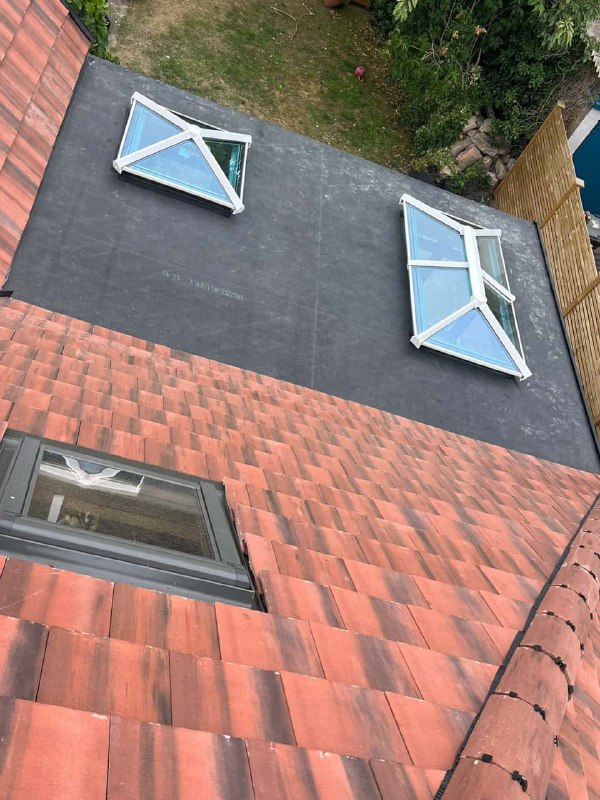Garage Roof Leaks Often Start With Minor Flashing Cracks
Many homeowners assume that when a garage roof starts leaking, it must be caused by broken tiles or worn felt. However, in many cases, the problem begins much smaller — with a tiny crack or gap in the flashing. Over time, this minor issue can develop into a major leak, leading to water damage, dampness, and structural concerns. At FCB Roofing Cranfield, we often find that early flashing faults are one of the most common culprits behind persistent garage roof leaks across Cranfield and the wider Bedfordshire area.
Understanding Flashing and Its Role
Flashing is the thin, weatherproof material — usually made of metal, lead, or a high-quality membrane — that seals the joints and edges on your roof. It’s commonly found around:
- Chimneys and skylights
- Roof junctions and valleys
- Edges where the roof meets walls or adjoining structures
- The perimeter of flat or garage roofs
Its primary purpose is to prevent water from penetrating the roof at vulnerable points. When flashing is properly installed and maintained, it provides long-lasting protection. But even a small defect can allow water to seep in unnoticed, causing damage beneath the surface.
How Flashing Cracks Develop
Garage roofs, particularly those with flat or low-pitched designs, are more prone to flashing wear and tear. Several factors contribute to the formation of cracks or gaps:
1. Weathering and Temperature Changes
In Bedfordshire, fluctuating temperatures, frost, and heavy rain can cause metal flashing to expand and contract. Over time, this movement creates small splits or gaps where water can infiltrate.
2. Poor Installation or Weak Sealing
If flashing isn’t installed correctly — or if it’s sealed with low-quality materials — it can start to lift or pull away from the surface. This creates an open path for moisture.
3. Roof Movement and Settling
As your garage structure settles or shifts slightly over the years, flashing can loosen. This is especially common on older properties where the roof frame has experienced decades of minor movement.
4. Corrosion and Deterioration
Metal flashing, particularly if exposed to standing water or moss, can corrode and weaken. In coastal or damp areas, such as parts of Bedfordshire, this process may happen faster.
5. Physical Damage
Even something as simple as a misplaced footstep during roof maintenance can crack or bend flashing, compromising its seal.
The Hidden Dangers of Small Cracks
At first glance, a tiny crack in your flashing may seem insignificant. However, water can travel a long distance beneath the surface before showing any visible signs of a leak.
Over time, even a small breach can lead to:
- Damp patches on the ceiling or walls of your garage
- Rotting roof timbers or decking
- Damaged insulation
- Mould growth and poor air quality
- Weakened roof integrity
By the time you notice visible signs of a leak inside the garage, the water may already have caused extensive hidden damage.
How to Spot Early Warning Signs
Detecting flashing damage early can save you from costly roof repairs. Regular visual inspections are key, especially after storms or freezing weather.
Look out for:
- Cracks or lifting around the flashing edges
- Discolouration or rust spots on metal flashing
- Damp patches near walls or roof joins
- Drips or water trails appearing after heavy rain
- Moss or vegetation growth around joints
If you’re unsure where the leak is coming from, it’s best to have the roof checked by professionals such as FCB Roofing Cranfield. We use careful inspection techniques to pinpoint the source of the leak rather than simply addressing the visible symptoms.
Why Garage Roofs Are Especially Vulnerable
Garage roofs are often more exposed to environmental stress than the main house roof. They may have a shallower pitch, less ventilation, and fewer insulation layers. This makes them more susceptible to moisture build-up and material fatigue.
Flat roofs, in particular, rely heavily on perfectly sealed flashing because standing water tends to collect near joints or edges. Once flashing cracks even slightly, water can easily penetrate the layers below, leading to damp insulation and rot.
Professional Flashing Repair and Maintenance
Repairing flashing isn’t just about applying sealant over the crack — a common mistake many homeowners make. Proper repair involves assessing the extent of the damage, removing deteriorated material, and resealing or replacing sections with precision.
At FCB Roofing Cranfield, our approach includes:
- Thorough inspection of all flashing joints and adjoining materials
- Replacement or re-bedding of damaged flashing sections
- Application of high-performance sealants and waterproof barriers
- Ensuring proper overlap and water flow to prevent future leaks
We ensure every repair is completed with close attention to detail, preventing future water ingress and protecting the structure for years to come.
Preventing Flashing Damage in the Future
While flashing will naturally degrade over time, there are steps you can take to extend its life and maintain a watertight roof.
Recommended maintenance steps:
- Schedule periodic roof inspections, especially after harsh weather.
- Keep gutters and downpipes clear to prevent standing water.
- Remove moss and debris buildup near flashing.
- Re-seal or re-paint flashing as part of routine roof maintenance.
- Replace old flashing when re-roofing or resurfacing the garage.
These proactive measures reduce the risk of unnoticed cracks developing and help ensure your garage roof continues to perform reliably.
Why Homeowners in Cranfield Trust FCB Roofing Cranfield
Local homeowners and businesses in Cranfield and surrounding Bedfordshire areas rely on FCB Roofing Cranfield for high-quality, dependable roof repairs. Our expertise extends to identifying and fixing subtle flashing issues before they turn into major leaks.
With professional craftsmanship and detailed inspections, we ensure every roof we work on is watertight, secure, and built to withstand the region’s changing weather conditions.
Conclusion
A garage roof leak rarely starts as a major failure — it’s often the result of a small crack or gap in the flashing that’s been overlooked. Over time, these minor issues can escalate into significant structural problems if left untreated. By scheduling regular inspections and acting quickly on early warning signs, you can prevent unnecessary damage and extend the life of your garage roof. For professional flashing repairs and expert roof maintenance across Cranfield and Bedfordshire, FCB Roofing Cranfield is the trusted name for lasting solutions that protect your property from the top down.
Call us on: 01234 981 898
Click here to find out more about FCB Roofing Cranfield
Click here to complete our contact form and see how we can help with your roofing needs.

